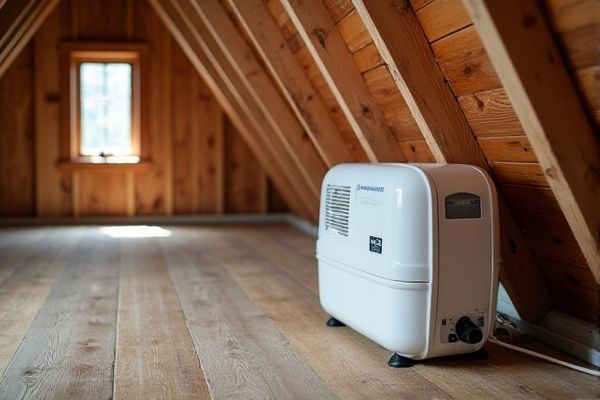
An attic humidity controller maintains optimal moisture levels by regulating ventilation and preventing excess humidity buildup, while a dehumidifier actively removes moisture from the air using refrigeration or desiccant technology. Understanding the differences between these solutions can help you choose the best option for protecting your attic space; read on to explore their benefits and applications.
Table of Comparison
| Feature | Attic Humidity Controller | Dehumidifier |
|---|---|---|
| Primary Function | Regulates humidity by ventilation control | Removes moisture from air via condensation |
| Operation | Automatically opens/closes vents based on humidity levels | Runs electric compressor or desiccant wheel to dry air |
| Energy Consumption | Low, uses minimal power for controls and vent motors | High, continuous power usage required |
| Installation Location | Installed in attic ventilation systems | Placed inside attic or living space |
| Maintenance | Minimal - periodic inspection of vents and sensors | Regular filter changes and water removal needed |
| Effectiveness | Best for controlling humidity passively | Efficient moisture removal, active humidity control |
| Cost | Lower upfront cost | Higher upfront and operational costs |
| Ideal Use | Homes with proper attic ventilation | High humidity areas or poorly ventilated attics |
Understanding Attic Humidity: Why It Matters
Controlling attic humidity is crucial because excess moisture can lead to mold growth, wood rot, and insulation damage, compromising your home's structural integrity and energy efficiency. An attic humidity controller specifically monitors and maintains optimal moisture levels by activating ventilation or dehumidification systems when needed. Unlike a standard dehumidifier, which simply removes moisture, a humidity controller prevents problems by ensuring consistent humidity regulation tailored to attic conditions.
What Is an Attic Humidity Controller?
An attic humidity controller is a specialized device designed to monitor and regulate moisture levels in your attic, preventing excess humidity that can lead to mold growth, wood rot, and insulation damage. Unlike general dehumidifiers that reduce moisture in larger living spaces, attic humidity controllers often work in tandem with ventilation systems to maintain optimal air circulation and humidity balance. By targeting specific humidity thresholds, these controllers help protect structural integrity and improve energy efficiency in your home.
How Dehumidifiers Work in Attic Spaces
Dehumidifiers in attic spaces function by drawing moist air over cold coils, causing condensation that removes excess water vapor and reduces humidity levels. This process helps prevent mold growth, wood rot, and insulation damage, ensuring the structural integrity and energy efficiency of your home. Using a dedicated attic humidity controller can optimize this operation by continuously monitoring and adjusting humidity settings for precise moisture management.
Key Differences: Attic Humidity Controller vs Dehumidifier
An attic humidity controller regulates moisture levels by activating ventilation systems or fans based on humidity sensors, ensuring optimal airflow and preventing mold growth. In contrast, a dehumidifier mechanically removes excess moisture from the air using refrigeration or desiccant technology, directly lowering humidity without altering ventilation. Understanding these key differences helps you choose the best solution for maintaining healthy attic humidity and protecting your home's structural integrity.
Benefits of Using an Attic Humidity Controller
An attic humidity controller precisely monitors and regulates moisture levels, preventing mold growth and structural damage by maintaining optimal humidity in confined attic spaces. Unlike standard dehumidifiers, it operates automatically based on real-time humidity data, enhancing energy efficiency and reducing operational costs. This targeted control extends the lifespan of insulation and roofing materials, fostering a healthier home environment and protecting your investment.
Advantages and Limitations of Dehumidifiers
Dehumidifiers effectively reduce excess moisture in attics, preventing mold growth and structural damage while improving indoor air quality. They offer precise humidity control and are available in various sizes to suit different spaces, but their energy consumption and maintenance demands can be higher compared to passive attic humidity controllers. Limited airflow in attics may reduce dehumidifier efficiency, and devices require regular drainage or water collection management to operate effectively.
Energy Efficiency: Which Solution Saves More?
Attic humidity controllers are designed to maintain optimal moisture levels by activating ventilation systems only when necessary, resulting in significantly lower energy consumption compared to continuous-running dehumidifiers. Dehumidifiers typically consume more electricity due to their constant operation and refrigeration components. Your choice impacts energy bills directly, making attic humidity controllers the more energy-efficient solution for regulating attic moisture.
Installation and Maintenance Comparison
An attic humidity controller typically requires professional installation to integrate with existing HVAC systems, ensuring precise humidity regulation with minimal user intervention. In contrast, a dehumidifier is generally easier to install, often plug-and-play, but demands regular maintenance such as emptying water tanks and cleaning filters to operate efficiently. Your choice depends on whether you prefer a low-maintenance, system-integrated solution or a more hands-on device with flexible installation options.
Cost Considerations: Upfront and Ongoing Expenses
Attic humidity controllers typically have lower upfront costs compared to dehumidifiers, making them a budget-friendly option for maintaining optimal moisture levels. Ongoing expenses for humidity controllers are minimal since they primarily regulate ventilation and use less energy, whereas dehumidifiers incur higher electricity costs due to continuous operation. You should weigh these cost factors based on your attic's specific humidity challenges and long-term maintenance budget.
Choosing the Best Solution for Your Attic’s Humidity Control
An attic humidity controller specifically monitors and maintains optimal moisture levels by activating ventilation systems only when necessary, ensuring energy efficiency and preventing mold growth. Dehumidifiers actively remove moisture from the air but may consume more power and require regular maintenance. Choosing the best solution depends on your attic's ventilation setup, humidity levels, and energy consumption preferences to protect your home effectively.
 homyna.com
homyna.com